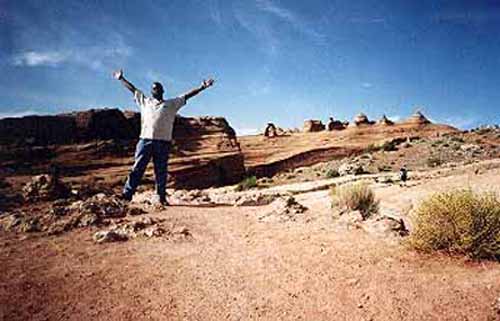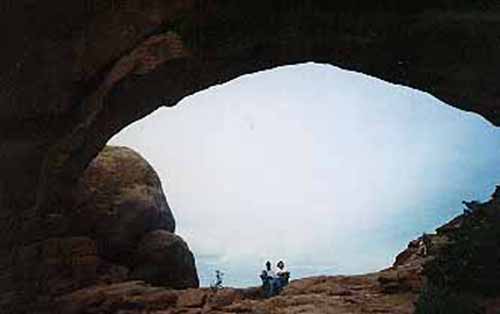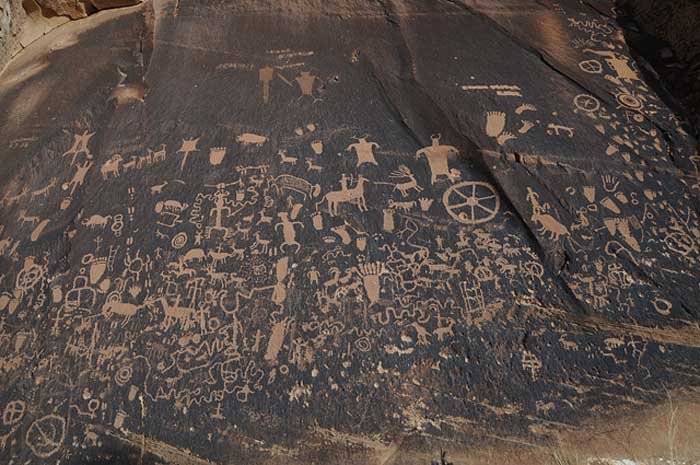
Anthropologists Steven Stewart and Nicole Torres

Archeological evidence suggests that the Moab area and surrounding country was inhabited by the Anasazi (in Navajo language, the ancient ones). The present town of Moab sits on the ruins of pueblo farming communities dating from the 11th and 12th centuries. These Anasazi Indians mysteriously vacated the Four Corners area around 1300 AD, leaving ruins of their homes scattered throughout the area. The villages were never inhabited again. They were "burned, possibly by the inhabitants, shortly before abandonment.

Could they have been driven out by nomadic tribes, such as Utes or Navajos? There is no direct evidence that either group, or any other like them, was in the area that early. There is mounting evidence, however, that the Numic-speaking peoples, of whom the Utes and Paiutes are part, had spread northwestward out of southwestern Nevada and were in contact with the Pueblo-like peoples of western Utah by A.D. 1200. It is certainly possible that they were in San Juan County shortly after that. Ute and Paiute sites are very difficult to distinguish from Anasazi campsites, and we may not be recognizing them.
Navajos were in northwestern New Mexico by 1500, but we do not know where they were before that. Perhaps the answer to the Anasazis' departure from Utah lies in a combination of the bad-climate and the arriving-nomads theories.
The Ancestral Puebloans migrated from their ancient homeland for several complex reasons. These may include pressure from Numic-speaking peoples moving onto the Colorado Plateau as well as climate change which resulted in agricultural failures.
Confirming evidence for climatic change in North America is found in excavations of western regions in the Mississippi Valley between A.D. 1150 and 1350 which show long lasting patterns of warmer, wetter winters and cooler, dryer summers.
Most modern Pueblo peoples (whether Keresans, Hopi, or Tanoans) and historians like James W. Loewen, in his book Lies Across America, assert these people did not "vanish," as is commonly portrayed, but merged into the various pueblo peoples whose descendants still live in Arizona and New Mexico.
Many modern Pueblo tribes trace their lineage from settlements in the Anasazi area and areas inhabited by their cultural neighbors, the Mogollon. For example, the San Ildefonso Pueblo people believe that their ancestors lived in both the Mesa Verde area and the current Bandelier.
The term "Anasazi" was established in archaeological terminology through the Pecos Classification system in 1927. Archaeologist Linda Cordell discussed the word's etymology and use:
- "The name "Anasazi" has come to mean "ancient people," "ancient ones", although the word itself is Navajo, meaning "enemy ancestors." It is unfortunate that a non-Pueblo word has come to stand for a tradition that is certainly ancestral Pueblo.
The term was first applied to ruins of the Mesa Verde by Richard Wetherill, a rancher and trader who, in 1888-1889, was the first Anglo-American to explore the sites in that area. Wetherill knew and worked with Navajos and understood what the word meant.
The name was further sanctioned in archaeology when it was adopted by Alfred V. Kidder, the acknowledged dean of Southwestern Archaeology. Kidder felt that is was less cumbersome than a more technical term he might have used. Subsequently some archaeologists who would try to change the term have worried that because the Pueblos speak different languages, there are different words for "ancestor," and using one might be offensive to people speaking other languages.
Some modern Pueblo peoples object to the use of the term Anasazi, although there is still controversy among them on a native alternative. The modern Hopi use the word "Hisatsinom" in preference to Anasazi. However, Navajo Nation Historic Preservation Department (NNHPD) spokeman Ronald Maldonado has indicated the Navajo do not favor use of the term "Ancestral Puebloan." In fact, reports submitted for review by NNHPD are rejected if they include use of the term.
Archeologists are not sure why these ancient people deserted the cliff dwellings by the end of the thirteenth century. Some experts think that they ran from attacks from marauding groups of native peoples. Others believe that overuse of the land for agriculture, combined with a long drought, drove the people away. From Ellie Crystal